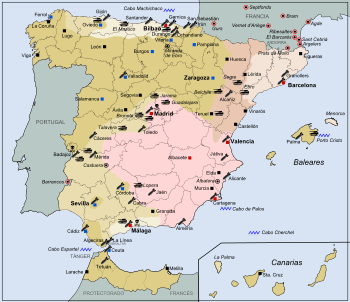Calvin Fixx
| Calvin Fixx | |
|---|---|
| Born |
Calvin Henry Fix August 1, 1906 Lyman, Idaho |
| Died |
March 3, 1950 (aged 43) Atlantic City, New Jersey |
| Cause of death | Heart attack |
| Nationality | American |
| Alma mater | University of Washington |
| Occupation | Editor, journalist, writer |
| Years active | 1926–1950 |
| Employer | Time, Life |
| Organization | Time, Inc. |
| Spouse(s) | Marlys Virginia Fuller Fixx (1906–2004) |
| Children | Jim Fixx (1932–1984), Katherine (Kitty) Fixx (1934- ) |
| Parent(s) | Henry Martin Fix (1883–1971), Maggie Priscilla Smith Fix (1888–1958) |
Calvin Fixx, born Calvin Henry Fix (August 1, 1906 – March 3, 1950), was a 20th-century American journalist and editor, lifelong friend of Robert Cantwell and friend of Whittaker Chambers, both fellow editors at TIME magazine. All three were either Marxist or Communist during the 1920s–1930s and then became Anti-Communist by 1939.[1][2][3]
Background

Calvin Fixx was born "Calvin Henry Fix" in Lyman, Idaho, on August 1, 1906, the son of Henry Martin Fix (1883–1971) and Maggie Priscilla Smith Fix (1888–1958). He had two brothers, Ford and Harley, and a sister, Georgia.[1][3]
He attended high school in Aberdeen, Washington, where he began a lifelong friendship with Robert Cantwell. He attended business school in Aberdeen briefly.[3]
Career

In 1927, Fixx hitchhiked cross-country to New York City. He took a part-time job in a Greenwich Village bookshop and wrote freelance book reviews. He took other jobs, such as secretary to author Lyle Saxon.[6] At this time, he added a second "x" to his surname because, he said, "a verb cannot be a name." He began to act informally as Cantwell's agent and helped him publish his first major short story. In 1929, he encouraged Robert Cantwell to come to New York City and they shared a flat in Greenwich Village."[3][4][5]
In 1936, he joined TIME with Robert Cantwell, Robert Fitzgerald, and James Agee.[1][3][6][7][8]
In early 1939, Fitzgerald resigned. In April 1939, Chambers was hired by Henry Luce, and Fixx joined Chambers in the Books section.[9][10] In 1940, William Saroyan lists Fixx among "contributing editors" at Time in Saroyan's play, Love's Old Sweet Song.[11]
In October 1942, while working in Times' "Back of the Book" section with Chambers, Fixx suffered a "severe heart attack", most probably brought on by the routine he and Chambers had adopted of "work[ing] a day and a half nonstop, stimulating themselves with six packs of cigarettes and a continual stream of coffee".[12] Luce gave him a year's leave and salary to recover.[2][3][4] (Wilder Hobson succeeded Fixx as assistant editor of Books.)[3] Chambers also suffered a heart attack a month later and also went on leave.[9][13] (Allen Weinstein notes that the FBI had visited Chambers in May 1942 to question him about his Communist activities.[14])
Upon Fixx's return, in 1943, he gave up editorial work for "special projects" (as did Chambers).[1][3] He also worked in the public relations department.[15]
Personal life and death

On October 31, 1930, Fixx married Marlys Virginia Fuller (1906–2004) of Michigan, a graduate of the 1929 class at Northwestern University.[3][16]
They lived at 3328 81 Street, Jackson Heights, Queens, New York.[1][3]
He died on March 3, 1950, of a second heart attack, in an Atlantic City hospital, at the age of 43. Fixx was survived by his wife, both parents, son James, daughter Catherine, brothers Ford and Harley, and sister Georgia.[1] His son, Jim Fixx, would also die of a heart attack, at the age of 52 in 1984.
Fixx is buried in Carmel, New York, in the Loudonsville Cemetery, in Putnam County, New York. Buried with him are his wife, son and grandparents.[17]
Impact
T.S. Matthews Staff

Fixx, close colleagues, and many staff members as of the 1930s helped elevate TIME–"interstitial intellectuals," as historian Robert Vanderlan has called them.[13] Colleague and best-selling author John Hersey described them as follows:
Time was in an interesting phase; an editor named Tom Matthews had gathered a brilliant group of writers, including James Agee, Robert Fitzgerald, Whittaker Chambers, Robert Cantwell, Louis Kronenberger, and Calvin Fixx... They were dazzling. Time's style was still very hokey—"backward ran sentences till reeled the mind"—but I could tell, even as a neophyte, who had written each of the pieces in the magazine, because each of these writers had such a distinctive voice.[18]
Colleagues
Fixx's death at age 43 profoundly affected his close friends. His death helped take away all motivation in Cantwell to write.[4] In his memoir, Chambers described Fixx as "my closest friend at Time.[9] Chambers recorded the death in a letter to another friend:
This morning, at 7 o'clock, died the friend who knew most about me, a man on whom I built an absolute trust, and to whose wisdom, patience, courage, and humility I constantly repaired–Calvin Fixx."[19]
Chambers took his son John to Fixx's funeral.[15]
Fixx was in charge of novelist Sloan Wilson when Wilson joined TIME.[20]
Communism and the Hiss Case

In the 1930s during the Popular Front years, Fixx was either a member of the CPUSA or supportive of Marxism. By 1939 with the Hitler-Stalin Pact, he started toward Anti-Communism, following Cantwell and Chambers.[4]
In 1939, the triumvirate (Fixx, Cantwell, Chambers) challenged the Communist-controlled Time chapter of the Newspaper Guild by making a motion to send aid to Loyalists (Republicans) in the Spanish Civil War at a time, following the Hitler-Stalin Pact, Communists supported Nationalist (Falangists): they were defeated 42 to 3.[2][9]
During the first months of the Hiss Case (1948–1950), Chambers, feeling unable to face TIME offices, used to spend much time at Fixx's home.[15]
Supporters of Alger Hiss used Fixx's 1942 heart attack and 1950 death to criticize his 1942 supervisor Whittaker Chambers. Ardent Hiss supporter Meyer Zeligs elaborated how Chambers "drew into the orbit of this killing [work] schedule" Fixx.[21]
David Cort rewrote his own account:
A ghoulish episode occurred, instigated by that plausible Cagliostro on Time magazine, Whittaker Chambers. His totally unnecessary routine of working his foreign department through every night on black coffee reduced one willing colleague, Calvin Fixx, to a heart attack.[22]
Subsequent writers repeated this charge, often near-verbatim from Cort.[23]
Works
TIME did not give bylines during Fixx's tenure, but he also published elsewhere, including these in The New Republic:
- "King Cole by W.R. Burnett" (1936)[24]
- "The House of Tavelinck by Jo van Ammers-Kuller" (1938)[25]
- "Dynasty of Death by Taylor Caldwell" (1938)[26]
- "Meek Heritage by F.E. Sillanpaa" (1938)[27]
- "Horns for our Adornment by Aksel Sandemose" (1938)[28]
- "The Monument by Pamela Hansford Johnson" (1938)[29]
See also
References
- 1 2 3 4 5 6 "Calvin Fixx". The New York Times. 4 March 1950. Retrieved 15 December 2016.
- 1 2 3 Seyersted, Per (2004). Robert Cantwell: An American 1930s Radical Writer and His Apostasy. Oslo: Novus Press. ISBN 82-7099-397-2.
- 1 2 3 4 5 6 7 8 9 10 Hall, Foster (2000). "Calvin Henry Fixx". Family Search. Retrieved 15 December 2016.
- 1 2 3 4 5 Reed, T.V (2014). Robert Cantwell and the Literary Left: A Northwest Writer Reworks American Fiction. University of Washington. pp. 26–27. Retrieved 15 December 2016.
- 1 2 Steiner, Michael C. (2015). Regionalists on the Left: Radical Voices from the American West. University of Oklahoma Press. Retrieved 15 December 2016.
- 1 2 Chance, Harvey. The Life and Selected Letters of Lyle Saxon. Pelican Publishing. Retrieved 15 December 2016.
- ↑ Fitzgerald, Robert (17 June 2016). "James Agee". This Recording. Retrieved 15 December 2016.
- ↑ "Letters : Calvin and Marlys Fixx to Bob and Eleanor Fitzgerald". Yale University Library. Retrieved 15 December 2016.
- 1 2 3 4 Chambers, Whittaker (1952). Witness. New York: Random House. pp. 478, 494–495. LCCN 52005149.
- ↑ Fitzgerald, Robert (1993). The Third Kind of Knowledge. New York: New Directions. p. 93.
- ↑ Saroyan, William (1940). Love's Old Sweet Song: A Play in Three Acts. Samuel French. p. 72, 76. Retrieved 15 July 2017.
- ↑ Hartshorn, L. (2013), Alger Hiss, Whittaker Chambers and the Case That Ignited McCarthyism, McFarland & Company, Jefferson, North Carolina and London, p. 66
- 1 2 Vanderlan, Robert (2011). Intellectuals Incorporated: Politics, Art, and Ideas Inside Henry Luce's Media Empire. University of Pennsylvania Press. p. 239. Retrieved 15 December 2016.
- ↑ Weinstein, Allen (1978). Perjury: The Hiss-Chambers Case. Random House. Retrieved 15 December 2016.
- 1 2 3 Tanenhaus, Sam (1997). Whittaker Chambers: A Biography. Random House. Retrieved 15 December 2016.
- ↑ "In Which When James Agee Woke He Was Almost Home". Northwestern University. 17 June 1929. Retrieved 15 December 2016.
- ↑ "Calvin Henry Fixx". Find A Grave. Retrieved 15 December 2016.
- ↑ Dee, Jonathan (1986). "John Hersey, The Art of Fiction No. 92". Paris Review. Retrieved 16 December 2016.
- ↑ Chambers, Whittaker; de Toledano, Ralph (1997). Notes from the underground: the Whittaker Chambers-- Ralph de Toledano letters : 1949–1960. Regnery Publishers. p. 17. Retrieved 15 December 2016.
- ↑ Wilson, Sloan (1976). What Shall We Wear to This Party?: The Man in the Gray Flannel Suit Twenty Years Before & After. Arbor House. pp. 21, 171–172. Retrieved 15 December 2016.
- ↑ Zeligs, Meyer (1967). Friendship and Fratricide. Viking. pp. 308–309. Retrieved 15 December 2016.
- ↑ Cort, David (1974). The Sin of Henry R. Luce: An Anatomy of Journalism. L. Stuart. pp. 149, 300 (ghoulish). Retrieved 15 December 2016.
- ↑ Hartshorn, Lewis (2013). Alger Hiss, Whittaker Chambers, and the Case that Ignited McCarthyism. McFarland (self-published). p. 66. Retrieved 16 December 2016.
- ↑ Fixx, Calvin (21 October 1936). "Fiction Round-Up: King Cole by W.R. Burnett". The New Republic. Retrieved 15 December 2016.
- ↑ Fixx, Calvin (19 October 1938). "King Cole by W.R. Burnett". The New Republic. Retrieved 15 December 2016.
- ↑ Fixx, Calvin (19 October 1938). "Dynasty of Death by Taylor Caldwell". The New Republic. Retrieved 15 December 2016.
- ↑ Fixx, Calvin (19 October 1938). "Meek Heritage by F.E. Sillanpaa". The New Republic. Retrieved 15 December 2016.
- ↑ Fixx, Calvin (19 October 1938). "Horns for our Adornment by Aksel Sandemose". The New Republic. Retrieved 15 December 2016.
- ↑ Fixx, Calvin (19 October 1938). "The Monument by Pamela Hansford Johnson". The New Republic. Retrieved 15 December 2016.
External sources
- "Calvin Fixx". The New York Times. 4 March 1950. Retrieved 15 December 2016.
- "Calvin Henry Fixx". Find A Grave. Retrieved 15 December 2016.